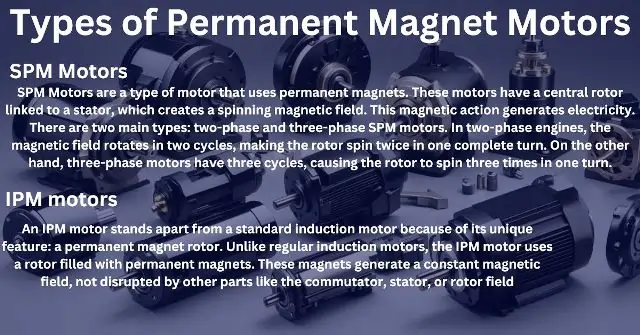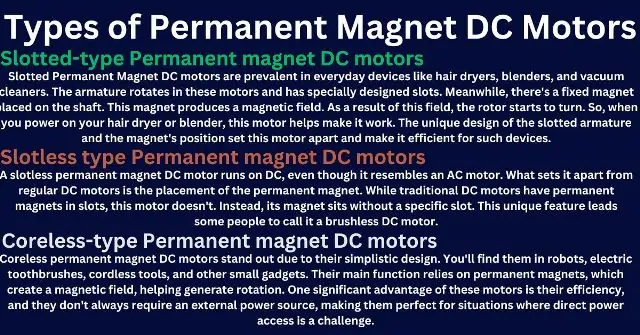The Best Permanent Magnet Motors
Permanent magnet motors are typically used in many different types of applications. They are usually used to power devices or equipment constantly rotating like a fan or a motor. It can also power a rotating flywheel or use the motor to create torque by driving a gearbox. The permanent magnet motor is used in many different ways. This article will review the uses of the permanent magnet motor and how these motors should be selected.
Permanent magnet motors are becoming a popular choice for a variety of industries.
Permanent magnet motors are a special kind of motor. They use a magnet and an electric coil to make a magnetic field. The rotor inside has its magnet, which stays magnetic all the time. Because of this, the rotor spins at a steady speed. It doesn’t get slowed down or sped up by unwanted electric effects.
Permanent magnet motors provide significant torque and horsepower for their size, making them ideal for applications where power and size are both necessary. This article will explore the different types of permanent magnet motors.
What is a permanent magnet motor?
Permanent magnet motors have changed the game in the world of electric motors. Unlike traditional motors, they harness the power of permanent magnets to generate movement. This slight adjustment makes them work better, using less power for the same task. Regular electric motors, called AC motors, need electricity to make a magnetic field. But PM motors skip this step. Instead, they use the constant magnetic force from the permanent magnets. This means they don’t waste energy creating a magnetic field, reducing electricity costs.
Another advantage is their size. Because of their efficiency, they can be more compact, making them perfect for devices where space is a premium. Think of electronic gadgets or even some advanced vehicles; the compactness of these motors can be a significant advantage.
In summary, permanent magnet or PM motors are an excellent choice if you’re looking for an energy-efficient and compact motor. They offer performance and energy savings, making them ideal for various applications. As technology advances, the significance and use of PM motors are likely to grow even more.
Types of Permanent Magnet Motors

SPM Motors (Surface Permanent magnets motors)
SPM Motors are a type of motor that uses permanent magnets. These motors have a central rotor linked to a stator, which creates a spinning magnetic field. This magnetic action generates electricity. There are two main types: two-phase and three-phase SPM motors. In two-phase engines, the magnetic field rotates in two cycles, making the rotor spin twice in one complete turn. On the other hand, three-phase motors have three cycles, causing the rotor to spin three times in one turn.
To build an SPM motor, you need a rotor and a stator. Typically, makers use metal, like iron, for the stator. For the rotor, they use magnetic materials, often steel. Wires, coiled around, connect the rotor and stator. These wire coils come in two types: self-exciting and exciting coils. Self-exciting coils get energy from the stator’s spinning magnetic field, while exciting coils draw from the rotor’s field. A motor changes electrical power into motion, making a shaft rotate.
IPM motors (Internal Permanent magnet motors).
An IPM motor stands apart from a standard induction motor because of its unique feature: a permanent magnet rotor. Unlike regular induction motors, the IPM motor uses a rotor filled with permanent magnets. These magnets generate a constant magnetic field, not disrupted by other parts like the commutator, stator, or rotor field.
The heart of the IPM motor is its permanent magnet rotor. This rotor produces the magnetic field essential for the motor’s operation. How does it work? The permanent magnet rotor generates a magnetic field by leveraging its magnetic flux. This magnetic field, in turn, powers the motor, creating a rotating force. The stator and the rotor harness this rotating magnetic field to make the motor run. Thanks to the permanent magnet rotor, the absence of interruptions in the magnetic flow is a defining feature of the IPM motor.
In summary, while IPM and standard induction motors serve similar functions, the permanent magnet rotor in the IPM motor sets it apart, offering a more consistent and efficient magnetic field for driving the motor.
Types of Permanent Magnet DC Motors

Slotted-type Permanent magnet DC motors
Slotted Permanent Magnet DC motors are prevalent in everyday devices like hair dryers, blenders, and vacuum cleaners. The armature rotates in these motors and has specially designed slots. Meanwhile, there’s a fixed magnet placed on the shaft. This magnet produces a magnetic field. As a result of this field, the rotor starts to turn. So, when you power on your hair dryer or blender, this motor helps make it work. The unique design of the slotted armature and the magnet’s position set this motor apart and make it efficient for such devices.
Slotless type Permanent magnet DC motors
A slotless permanent magnet DC motor runs on DC, even though it resembles an AC motor. What sets it apart from regular DC motors is the placement of the permanent magnet. While traditional DC motors have permanent magnets in slots, this motor doesn’t. Instead, its magnet sits without a specific slot. This unique feature leads some people to call it a brushless DC motor.
These slotless motors maintain their magnetism, ensuring the magnet doesn’t lose power over time. Another name for slotless DC motors is continuous reluctance motors. By not having slots, these motors offer certain benefits over the traditional design, making them an excellent choice for specific applications. Remember, the key difference is how and where the magnet sits inside the motor.
Coreless-type Permanent magnet DC motors
Coreless permanent magnet DC motors stand out due to their simplistic design. You’ll find them in robots, electric toothbrushes, cordless tools, and other small gadgets. Their main function relies on permanent magnets, which create a magnetic field, helping generate rotation. One significant advantage of these motors is their efficiency, and they don’t always require an external power source, making them perfect for situations where direct power access is a challenge.
Where can you use Coreless Permanent magnet DC motors? Their adaptability is what makes them special. These motors fit well in various roles:
- Driving aircrafts
- Operating pumps
- Generating electricity
- Powering belt drives
- Aiding robotic movement
- Running medical equipment
- Spinning computer hard disks
- Directing GPS devices
- Functioning in industrial machinery
- Operating both pneumatic and vacuum systems
These motors are everywhere, offering a reliable solution in diverse fields.
Permanent Magnet Motor Materials
Materials for Permanent Magnets:
- Primary components: The main metals in permanent magnets are iron and nickel. These are chosen for their magnetic properties and ability to hold a magnetic charge.
- Additional element: Manufacturers mix these metals with magnetite. This mineral, abundant in nature, enhances the magnet’s strength due to its inherent magnetic qualities.
Manufacturing Process:
- Makers heat the combination of iron, nickel, and magnetite until it reaches a molten state.
- They then pour this heated mixture into molds to shape the magnet.
- Once cooled and solidified, artisans cut the now solid magnet to achieve the desired dimensions.
- After cutting, the surface of the magnet undergoes polishing to give it a smooth finish.
- Manufacturers apply a protective layer to ensure the magnet’s longevity and prevent corrosion.
Unique Properties of Iron:
- Iron classifies as a ferromagnetic material, responding to magnetic fields and retaining a magnetic charge.
- If you wrap a wire around an iron piece and expose that system to a magnetic environment, something interesting happens. The magnetic field induces alternating current (AC) flow within the wire.
- Devices can convert this AC into direct current (DC). Many gadgets, from mobile phones to kitchen appliances, rely on DC power.
Permanent Magnet Motor Vs. Induction Motor Efficiency
Permanent Magnet Motor Efficiency
Permanent magnet motors usually outperform induction motors in terms of efficiency. The difference lies in the magnetic fields. Permanent magnet motors generate a stable and constant magnetic field. On the other hand, induction motors produce a temporary one. This stability in the magnetic field gives permanent magnet motors an edge in efficiency. The consistent magnetic field in permanent magnet motors leads to better performance when comparing the two.
Induction Motor Efficiency
Using an alternating current (AC) is the best method to drive an induction motor. Why? When you use an AC with a frequency of 60 Hz, the motor produces its strongest turning force or torque. Here, “frequency” means how often the current cycles in a single second. When you have a higher frequency, your motor works more efficiently. This AC doesn’t just power the motor; it also generates a magnetic field. This magnetic field makes the motor’s magnetic field rotate. The interaction of these magnetic fields causes the motor to spin.
Blog Conclusion
To summarize, our discussion today is super important in today’s world. AC is the heart of most motors, and knowing its frequency helps us understand how well a motor works. A higher frequency means a better working motor. It’s about how much power it has and how magnets help the motor spin. This isn’t just stuff for experts; everyone can learn how everyday gadgets work. We make better decisions and use our tech wisely when we know more. It’s also cool to think about how electricity and magnets work together in many things we use. Always remember: knowledge is power. Stay curious and keep exploring!
FAQ on “Permanent Magnet Motors
Q: What is a Permanent Magnet Motor?
A: A motor uses permanent magnets to create a magnetic field.
Q: Why choose Permanent Magnet Motors?
A: They’re energy-efficient and compact.
Q: Where are these motors used?
A: In electric vehicles, appliances, and machinery.
Q: How do they differ from Induction Motors?
A: They use permanent magnets, not electrical winding, for magnetic fields.
